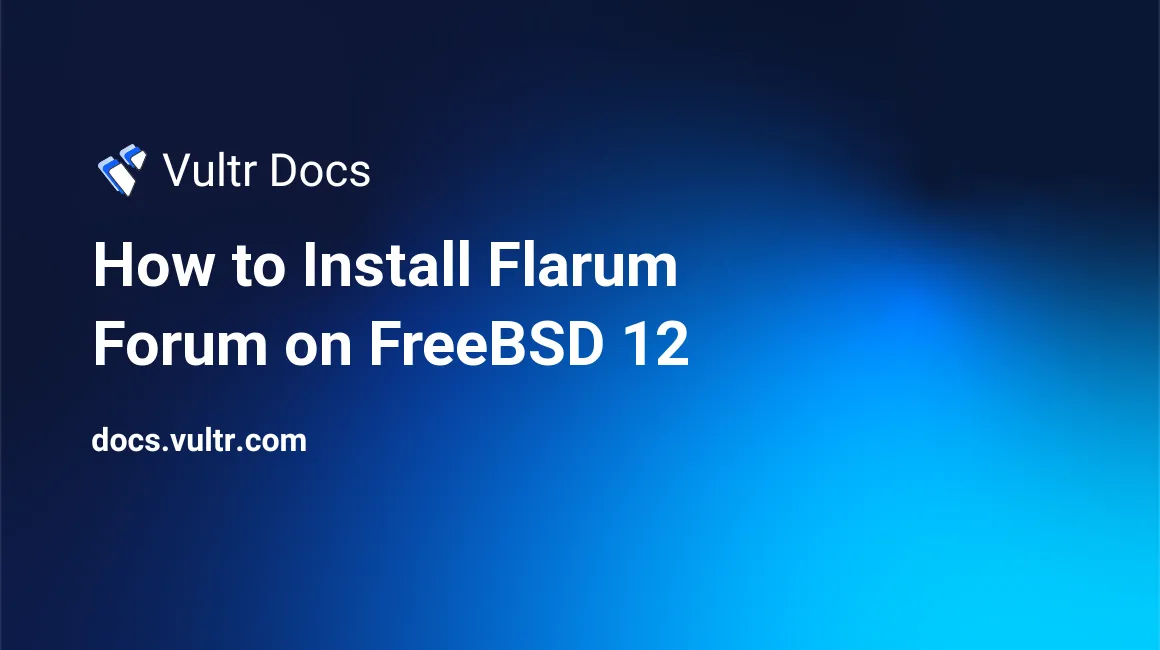
Flarum is a free and open-source next-generation forum software that makes online discussion fun. Flarum source code is hosted on Github. It is designed to be fast, simple, responsive, and extensible.
This guide will walk you through the Flarum installation process on a fresh FreeBSD 12.0 Vultr instance using PHP, MariaDB as a database, and Nginx as a web server.
Requirements
Before you install Flarum, it's important to check that your server meets the requirements. To run Flarum, you will need:
- Apache (with
mod_rewriteenabled) or Nginx. This guide will use Nginx. - PHP version 7.1 or greater with the following PHP extensions:
dom,gd,JSON,mbstring,OpenSSL,pdo_mysql,tokenizer. - MySQL version 5.6 or greater or MariaDB version 10.0.5 or greater. This guide will use MariaDB.
Before you begin
Check the FreeBSD version.
uname -ro
# FreeBSD 12.0-RELEASE-p6Ensure that your FreeBSD system is up to date.
freebsd-update fetch install
pkg update && pkg upgrade -yInstall the necessary packages.
pkg install -y sudo vim unzip curl wget bash socat gitCreate a new user account with your preferred username. We will use johndoe.
adduser
# Username: johndoe
# Full name: John Doe
# Uid (Leave empty for default): <Enter>
# Login group [johndoe]: <Enter>
# Login group is johndoe. Invite johndoe into other groups? []: wheel
# Login class [default]: <Enter>
# Shell (sh csh tcsh nologin) [sh]: bash
# Home directory [/home/johndoe]: <Enter>
# Home directory permissions (Leave empty for default): <Enter>
# Use password-based authentication? [yes]: <Enter>
# Use an empty password? (yes/no) [no]: <Enter>
# Use a random password? (yes/no) [no]: <Enter>
# Enter password: your_secure_password
# Enter password again: your_secure_password
# Lock out the account after creation? [no]: <Enter>
# OK? (yes/no): yes
# Add another user? (yes/no): no
# Goodbye!Run the visudo command and uncomment the %wheel ALL=(ALL) ALL line, to allow members of the wheel group to execute any command.
visudo
# Uncomment by removing hash (#) sign
# %wheel ALL=(ALL) ALLNow, switch to your newly created user with su.
su - johndoeNOTE: Replace johndoe with your username.
Set up the timezone.
sudo tzsetupInstall PHP
Install PHP, as well as the necessary PHP extensions.
sudo pkg install -y php72 php72-mbstring php72-tokenizer php72-pdo php72-pdo_mysql php72-openssl php72-hash php72-json php72-phar php72-filter php72-zlib php72-dom php72-xml php72-xmlwriter php72-xmlreader php72-curl php72-session php72-ctype php72-iconv php72-gd php72-simplexml php72-zip php72-filter php72-tokenizer php72-calendar php72-fileinfo php72-intl php72-phar php72-soap php72-xmlrpcCheck the version.
php --version
# PHP 7.2.21 (cli) (built: Aug 4 2019 01:12:37) ( NTS )
# Copyright (c) 1997-2018 The PHP Group
# Zend Engine v3.2.0, Copyright (c) 1998-2018 Zend TechnologiesSoft-link php.ini-production to php.ini.
sudo ln -s /usr/local/etc/php.ini-production /usr/local/etc/php.iniEnable and start PHP-FPM.
sudo sysrc php_fpm_enable=yes
sudo service php-fpm startInstall MariaDB
Install MariaDB.
sudo pkg install -y mariadb102-client mariadb102-serverCheck the version.
mysql --version
# mysql Ver 15.1 Distrib 10.2.25-MariaDB, for FreeBSD12.0 (amd64) using readline 5.1Start and enable MariaDB.
sudo sysrc mysql_enable="yes"
sudo service mysql-server startRun the mysql_secure_installation script to improve the security of your MariaDB installation.
sudo mysql_secure_installationLog into MariaDB as the root user.
mysql -u root -p
# Enter password:Create a new MariaDB database and user. Remember the credentials for this new user.
CREATE DATABASE dbname;
GRANT ALL ON dbname.* TO 'username' IDENTIFIED BY 'password';
FLUSH PRIVILEGES;
exit;NOTE: Replace dbname and username with appropriate names for your setup. Replace password with a strong password.
Install Nginx
Install Nginx.
sudo pkg install -y nginxCheck the version.
nginx -v
# nginx version: nginx/1.16.0Enable and start Nginx.
sudo sysrc nginx_enable=yes
sudo service nginx startConfigure Nginx for Flarum. Run sudo vim /usr/local/etc/nginx/flarum.conf and populate the file with the following configuration.
server {
listen [::]:80;
listen 80;
server_name example.com;
root /usr/local/www/flarum/public;
index index.php;
location / {
try_files $uri $uri/ /index.php?$query_string;
}
location ~* \.php$ {
fastcgi_pass 127.0.0.1:9000;
include fastcgi_params;
fastcgi_index index.php;
fastcgi_param SCRIPT_FILENAME $document_root$fastcgi_script_name;
}
}Save the file and exit with Colon+W+Q.
Now we need to include flarum.conf in the main nginx.conf file.
Run sudo vim /usr/local/etc/nginx/nginx.conf and add the following line to the http {} block.
include flarum.conf;Test the configuration.
sudo nginx -tReload Nginx.
sudo service nginx reloadInstall Composer
Download and install Composer, the dependency manager for PHP.
php -r "copy('https://getcomposer.org/installer', 'composer-setup.php');"
php -r "if (hash_file('sha384', 'composer-setup.php') === 'a5c698ffe4b8e849a443b120cd5ba38043260d5c4023dbf93e1558871f1f07f58274fc6f4c93bcfd858c6bd0775cd8d1') { echo 'Installer verified'; } else { echo 'Installer corrupt'; unlink('composer-setup.php'); } echo PHP_EOL;"
php composer-setup.php
php -r "unlink('composer-setup.php');"
sudo mv composer.phar /usr/local/bin/composerCheck the version.
composer --version
# Composer version 1.9.0 2019-08-02 20:55:32Install Flarum
NOTE: Flarum is currently in the beta stage. It is not recommended to run it in production just yet unless you know what you are doing. You should wait for stable release for production usage.
Create a document root directory.
sudo mkdir -p /usr/local/www/flarumChange ownership of the /usr/local/www/flarum directory to johndoe.
sudo chown -R johndoe:johndoe /usr/local/www/flarumNavigate to the document root folder.
cd /usr/local/www/flarumDownload the latest release of Flarum via composer.
composer create-project flarum/flarum . --stability=betaNOTE: You may run out of memory when installing Flarum via Composer. If that happens, then you'll need to setup Swap.
Change ownership of the /usr/local/www/flarum directory to www.
sudo chown -R www:www /usr/local/www/flarumOpen your site in a web browser and follow the instructions on the screen to finish the installation.
No comments yet.